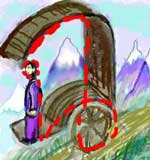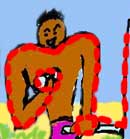A little while ago I stumbled across a cool book called Learn The Thai Alphabet In A Day, which teaches an alternative way of learning the Thai alphabet. I had just started learning Thai properly so this system intrigued me as an easier route to getting to grips with the Thai letters.
As you've probably already experienced the Thai “Gor Guy”, “Kor Kai”, “Por Samphao”, Ror Rua” “Lor Ling” system is a little alien to us foreign folk, and as such it can take many months to fully digest all 44 consonants – and then of course there are 32 vowels to learn after that…..sigh.
This book, however, uses fun illustrations that help those who've been brought up using the western alphabet get to grips with the Thai alphabet.
Why This Book is Awesome
It's awesome because it's very intelligent, and no doubt took a long time for the author to put together. It basically takes a letter of the Thai alphabet and creates an illustration that represents the sound of the Thai letter. But that's not the clever part.
The genius is that the illustration replicates the shape of the Thai letter. And so, when you next see that Thai letter you'll remember it's name through a dual association. Here's a couple of examples:
Chor Ching = Chariot Traveller
This is the Thai letter Chor Ching. It's a “ch” sound and normally represented by cymbals in the Thai alphabet. The illustration resembles a Chariot with a traveller onboard, driving through mountainous Terrain. The imagery provides all the information you need to recall when looking at this Thai letter.
1. The sound is Ch (chariot), when used at the start of a word.
2. Its class is High, symbolised by the high mountainous terrain in the background

The illustrations have three backgrounds, each representing the three classes of consonants, as follows:
1. High class consonants have a mountainous background.
2. Middle class consonants have an urban background.
3. Low class consonants have a sea level, seaside background.
Tho Phu Thao = Training by the Sea
Here's another example: Tho Phu Thao, which is normally represented by an old man in the Thai alphabet, is represented here by a man training on Venice beach. The sound is ‘T', and again the shape of the Thai letter is seen in the illustration. This is a low consonant, as represented by the sea level landscape.
![]()
Pretty clever huh? So when my teacher says “write Tho Phu Thao”, I simply remember the guy training on Venice beach. The ‘M' shape with the two dumbbells is easy to draw, and I can even tell her what class the consonant is because I know he is on the beach!
Why Learning The Alphabet is a Must…Eventually
It's very common for foreigners to be able to speak Thai but to not be able to read Thai, which is strange, right? Not really, actually, because it's very easy to do. You can learn Thai from Thais and go to school without having to learn the alphabet.
There are plenty of phonetic English translation books, and new oral lessons pop up on Youtube daily. But the fact is, at some point you are going to have to learn the Thai alphabet, if not just for your own sanity.
If you start driving in Thailand you'll want to be able to read road signs, if you want to do business in Thailand you'll need to read contractual literature, and then there's the simple stuff like knowing how to spot a pharmacy sign, the correct gender toilet and basic street signs. Moreover, if you end up with half Thai children you'll want to be able to teach them.
If you are considering learning Thai then learning the Thai alphabet is a must, at least eventually, anyway, so you might as well make a start.
If you are struggling to learn the alphabet with the pictures they use to teach Thai children then this Learn The Thai Alphabet In A Day book will make things a lot easier for you.
As a disclaimer, a day is a little misleading, but certainly doable in a few days, if you put the work in.


